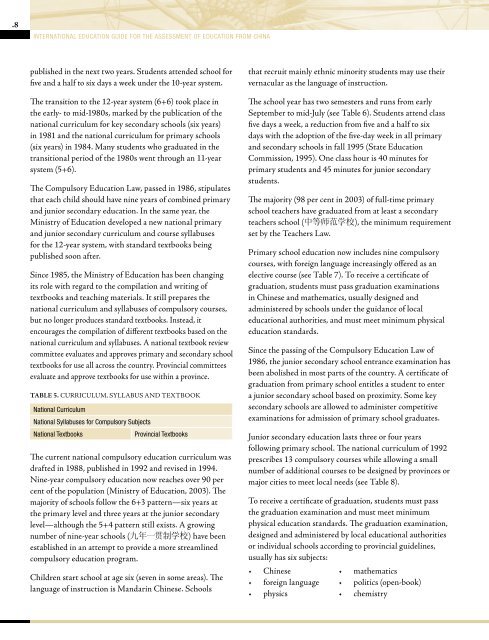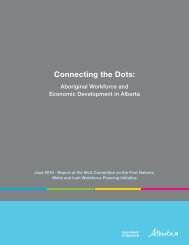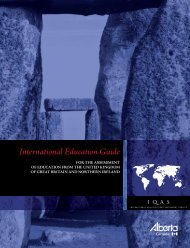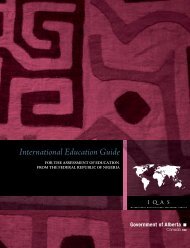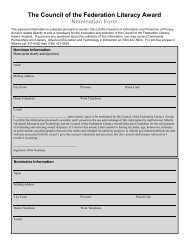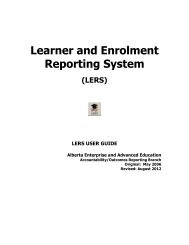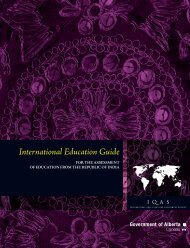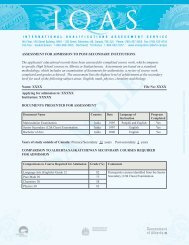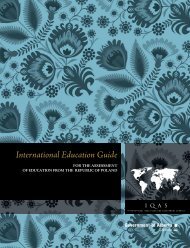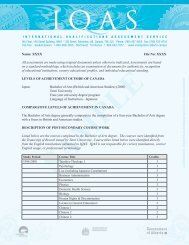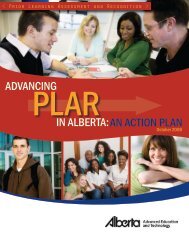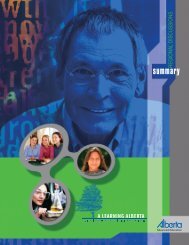International Education Guide - China - Enterprise and Advanced ...
International Education Guide - China - Enterprise and Advanced ...
International Education Guide - China - Enterprise and Advanced ...
Create successful ePaper yourself
Turn your PDF publications into a flip-book with our unique Google optimized e-Paper software.
.8<br />
INTERNATIONAL EDUCATION GUIDE FOR THE ASSESSMENT OF EDUCATION FROM CHINA<br />
published in the next two years. Students attended school for<br />
five <strong>and</strong> a half to six days a week under the 10-year system.<br />
The transition to the 12-year system (6+6) took place in<br />
the early- to mid-1980s, marked by the publication of the<br />
national curriculum for key secondary schools (six years)<br />
in 1981 <strong>and</strong> the national curriculum for primary schools<br />
(six years) in 1984. Many students who graduated in the<br />
transitional period of the 1980s went through an 11-year<br />
system (5+6).<br />
The Compulsory <strong>Education</strong> Law, passed in 1986, stipulates<br />
that each child should have nine years of combined primary<br />
<strong>and</strong> junior secondary education. In the same year, the<br />
Ministry of <strong>Education</strong> developed a new national primary<br />
<strong>and</strong> junior secondary curriculum <strong>and</strong> course syllabuses<br />
for the 12-year system, with st<strong>and</strong>ard textbooks being<br />
published soon after.<br />
Since 1985, the Ministry of <strong>Education</strong> has been changing<br />
its role with regard to the compilation <strong>and</strong> writing of<br />
textbooks <strong>and</strong> teaching materials. It still prepares the<br />
national curriculum <strong>and</strong> syllabuses of compulsory courses,<br />
but no longer produces st<strong>and</strong>ard textbooks. Instead, it<br />
encourages the compilation of different textbooks based on the<br />
national curriculum <strong>and</strong> syllabuses. A national textbook review<br />
committee evaluates <strong>and</strong> approves primary <strong>and</strong> secondary school<br />
textbooks for use all across the country. Provincial committees<br />
evaluate <strong>and</strong> approve textbooks for use within a province.<br />
Table 5. Curriculum, Syllabus <strong>and</strong> Textbook<br />
National Curriculum<br />
National Syllabuses for Compulsory Subjects<br />
National Textbooks<br />
Provincial Textbooks<br />
The current national compulsory education curriculum was<br />
drafted in 1988, published in 1992 <strong>and</strong> revised in 1994.<br />
Nine-year compulsory education now reaches over 90 per<br />
cent of the population (Ministry of <strong>Education</strong>, 2003). The<br />
majority of schools follow the 6+3 pattern—six years at<br />
the primary level <strong>and</strong> three years at the junior secondary<br />
level—although the 5+4 pattern still exists. A growing<br />
number of nine-year schools ( 九 年 一 贯 制 学 校 ) have been<br />
established in an attempt to provide a more streamlined<br />
compulsory education program.<br />
Children start school at age six (seven in some areas). The<br />
language of instruction is M<strong>and</strong>arin Chinese. Schools<br />
that recruit mainly ethnic minority students may use their<br />
vernacular as the language of instruction.<br />
The school year has two semesters <strong>and</strong> runs from early<br />
September to mid-July (see Table 6). Students attend class<br />
five days a week, a reduction from five <strong>and</strong> a half to six<br />
days with the adoption of the five-day week in all primary<br />
<strong>and</strong> secondary schools in fall 1995 (State <strong>Education</strong><br />
Commission, 1995). One class hour is 40 minutes for<br />
primary students <strong>and</strong> 45 minutes for junior secondary<br />
students.<br />
The majority (98 per cent in 2003) of full-time primary<br />
school teachers have graduated from at least a secondary<br />
teachers school ( 中 等 师 范 学 校 ), the minimum requirement<br />
set by the Teachers Law.<br />
Primary school education now includes nine compulsory<br />
courses, with foreign language increasingly offered as an<br />
elective course (see Table 7). To receive a certificate of<br />
graduation, students must pass graduation examinations<br />
in Chinese <strong>and</strong> mathematics, usually designed <strong>and</strong><br />
administered by schools under the guidance of local<br />
educational authorities, <strong>and</strong> must meet minimum physical<br />
education st<strong>and</strong>ards.<br />
Since the passing of the Compulsory <strong>Education</strong> Law of<br />
1986, the junior secondary school entrance examination has<br />
been abolished in most parts of the country. A certificate of<br />
graduation from primary school entitles a student to enter<br />
a junior secondary school based on proximity. Some key<br />
secondary schools are allowed to administer competitive<br />
examinations for admission of primary school graduates.<br />
Junior secondary education lasts three or four years<br />
following primary school. The national curriculum of 1992<br />
prescribes 13 compulsory courses while allowing a small<br />
number of additional courses to be designed by provinces or<br />
major cities to meet local needs (see Table 8).<br />
To receive a certificate of graduation, students must pass<br />
the graduation examination <strong>and</strong> must meet minimum<br />
physical education st<strong>and</strong>ards. The graduation examination,<br />
designed <strong>and</strong> administered by local educational authorities<br />
or individual schools according to provincial guidelines,<br />
usually has six subjects:<br />
• Chinese • mathematics<br />
• foreign language • politics (open-book)<br />
• physics • chemistry


